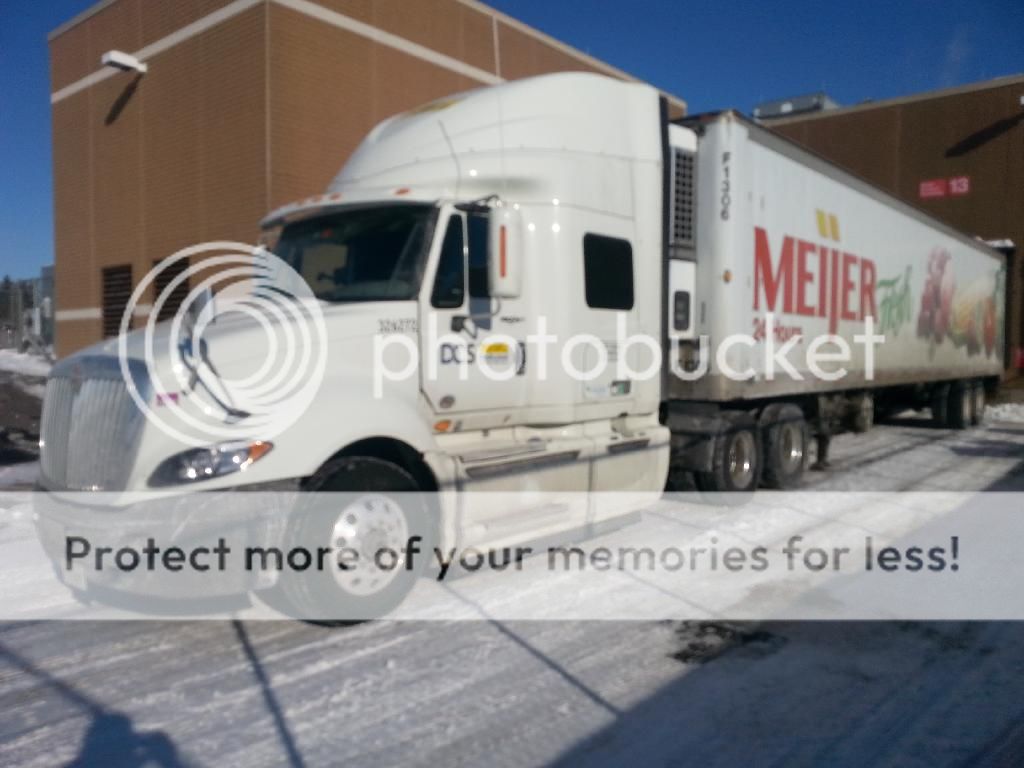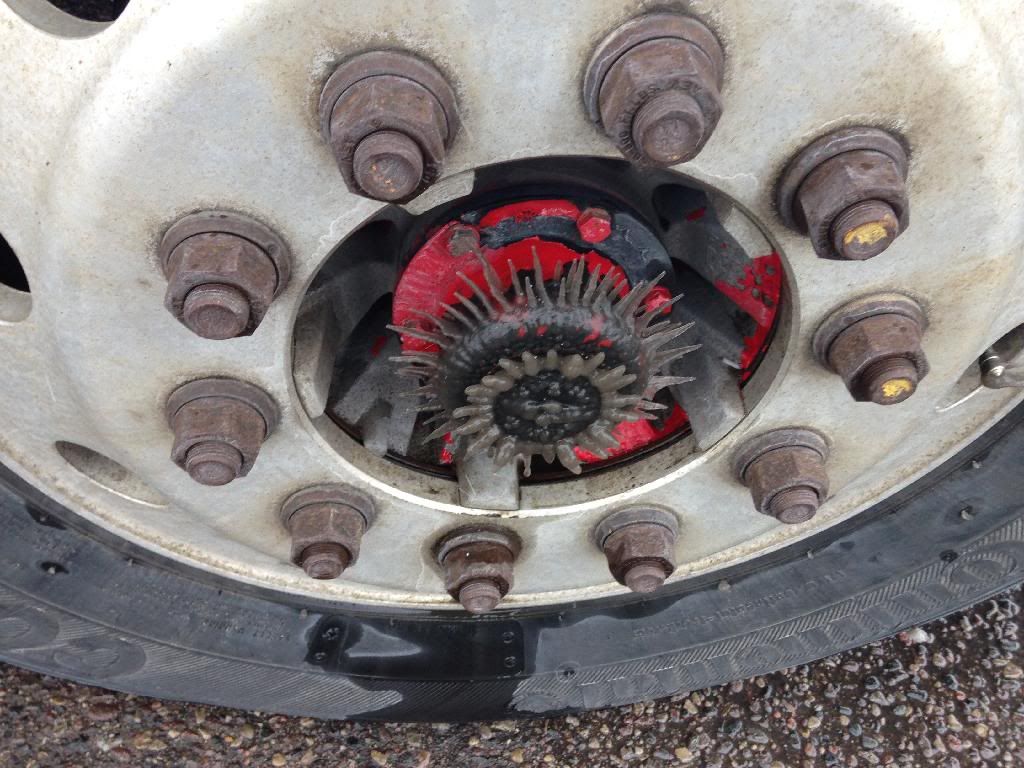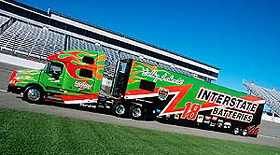Companies That Require Double Clutching
Topic 3013 | Page 2

I learned double clutching from the beginning. I still use the method and it is completely second nature to me now. When I joined my current company, I went out with a veteran driver for one night just to get the details and practices (paperwork, where the trailers are found, where the backhauls go when we get back, etc..), he was a gear floater. I watched him and it looks effortless and easy. I tried it a few times the next night in my own truck and it felt so foreign to me, I just went back to what felt right, double -clutching. Every driver will use the method that suits them best.
On a side note, with the increased city driving I now do, I am walking lop-sided because my left (clutch) leg is so much bigger and stronger than the other...lol.
Double Clutch:
To engage and then disengage the clutch twice for every gear change.
When double clutching you will push in the clutch, take the gearshift out of gear, release the clutch, press the clutch in again, shift the gearshift into the next gear, then release the clutch.
This is done on standard transmissions which do not have synchronizers in them, like those found in almost all Class A trucks.
Double Clutching:
To engage and then disengage the clutch twice for every gear change.
When double clutching you will push in the clutch, take the gearshift out of gear, release the clutch, press the clutch in again, shift the gearshift into the next gear, then release the clutch.
This is done on standard transmissions which do not have synchronizers in them, like those found in almost all Class A trucks.

Wine Taster, How does using the clutch effect fuel performance? Did they say how that works?
Stephen E. Birch
They said the progressive shifting is to save fuel. The double clutch is to slow down the synchronizer in the clutch so you don't slowly grind the parts away in the tranny. That's what the instructor said. I asked about floating gears after class and he said that it puts more wear and tear on the tranny.
Floating Gears:
An expression used to describe someone who is shifting gears without using the clutch at all. Drivers are taught to "Double Clutch" or press and release the clutch twice for each gear shift. If you're floating gears it means you're simply shifting without using the clutch at all.
Double Clutch:
To engage and then disengage the clutch twice for every gear change.
When double clutching you will push in the clutch, take the gearshift out of gear, release the clutch, press the clutch in again, shift the gearshift into the next gear, then release the clutch.
This is done on standard transmissions which do not have synchronizers in them, like those found in almost all Class A trucks.
The double clutch is to slow down the synchronizer in the clutch so you don't slowly grind the parts away in the tranny. That's what the instructor said. I asked about floating gears after class and he said that it puts more wear and tear on the tranny.
That's not true. Watch someone float gears who knows what they're doing and you'll immediately see you can shift as smooth as silk that way. It doesn't grind gears, it doesn't wear out the tranny.
Double-clutching wears the heck out of the clutch but somehow that never gets mentioned.
And there are no synchronizers in a big rig transmission. That's why you have to double clutch. You're manually synchronizing the engine speed with the transmission speed the second time you push in the clutch. Here's the basics:
When you're going down the road, the first time you push in the clutch you're taking any pressure off the gears so you can get it out of gear. But this also happens when you quickly let off the gas or tap the gas pedal. So you can relieve the pressure by pushing in the clutch or quickly changing the throttle position just for a moment. It will quickly and easily come out of gear either way.
Now you're rolling in neutral and you have to get it back into gear. If you pushed in the clutch to get it out of gear in the first place then you've now desynchronized the engine and transmission speeds so you have to let off the clutch when you're in neutral to synchronize them again. Once they're synchronized you can then push the clutch back in to put it back into gear. But again, pushing in the clutch isn't necessary at all if you don't clutch in the first place because you never desynchronized the engine and transmission speeds. And regardless of whether or not you push in the clutch to get it back into gear, it's only going to go into gear if the engine speed, transmission speed, and road speed all match up properly.
Now in a car, which has synchronizers, that last statement isn't true. You can generally push in the clutch and put the transmission in any gear at any speed, even a gear that's way too low for the speed you're travelling. The synchronizers will accelerate the transmission shaft speed to make that happen. But of course in a car if you let out the clutch in second gear at 50 mph you're going to rev the engine to the sky and blow it up. This isn't possible in a big rig because without synchronizers you can't get it in a gear that's too low for the speed you're travelling. The transmission speed won't accelerate that high without the synchronizers.
I would guess nowadays they've put safety features in place to make sure you can't put a car in 2nd gear at 50 mph. At least I hope they did. But I know back in the day they didn't. But heck, I drive a big ole redneck '77 Chevy 4WD with big mud tires so I don't know they do with modern car transmissions. I know I could throw one in the bed of my truck as a snack for Big Chevy on a long trip maybe.

Floating Gears:
An expression used to describe someone who is shifting gears without using the clutch at all. Drivers are taught to "Double Clutch" or press and release the clutch twice for each gear shift. If you're floating gears it means you're simply shifting without using the clutch at all.
Float Gears:
An expression used to describe someone who is shifting gears without using the clutch at all. Drivers are taught to "Double Clutch" or press and release the clutch twice for each gear shift. If you're floating gears it means you're simply shifting without using the clutch at all.
Double Clutch:
To engage and then disengage the clutch twice for every gear change.
When double clutching you will push in the clutch, take the gearshift out of gear, release the clutch, press the clutch in again, shift the gearshift into the next gear, then release the clutch.
This is done on standard transmissions which do not have synchronizers in them, like those found in almost all Class A trucks.

You explained it much better than I did Brett. Pretty much the same thing the instructor said. He said that it reduces wear on the tranny. I have no clue if that is true or not. They tell me to double clutch so I will double clutch. Still a newbie starting out so I have to follow whatever I am told.
Double Clutch:
To engage and then disengage the clutch twice for every gear change.
When double clutching you will push in the clutch, take the gearshift out of gear, release the clutch, press the clutch in again, shift the gearshift into the next gear, then release the clutch.
This is done on standard transmissions which do not have synchronizers in them, like those found in almost all Class A trucks.
They tell me to double clutch so I will double clutch. Still a newbie starting out so I have to follow whatever I am told.
Oh absolutely. You're required to double clutch to pass the driving test and most companies will want you to double clutch when you're on the road with a trainer. That will ultimately be at the discretion of the trainer. But it's one of those things you learn in school so you know how to do it and then you get out there and drive the way you see fit once you go solo.
Double Clutch:
To engage and then disengage the clutch twice for every gear change.
When double clutching you will push in the clutch, take the gearshift out of gear, release the clutch, press the clutch in again, shift the gearshift into the next gear, then release the clutch.
This is done on standard transmissions which do not have synchronizers in them, like those found in almost all Class A trucks.
HOS:
Hours Of Service
HOS refers to the logbook hours of service regulations.
Later on in your truckin career when you change companies and you will change to a few companies over the years you have to take a driving test before you get hired but the testers use a double standard of a sorts and I think they should.
At Werner during the 4 day orientation We had a driving test. Out of a class of 20 people 4 of us were experienced drivers. The instructor that was giving the test made all the new drivers that were fresh out of school double clutch and the experienced drivers he said we could float the gears if we wanted to.
I did not even complete the full driving test. He stopped me in the middle of 90 degree backing and said to pull around for the next driver. Of course I am good but I think an experienced driver/tester can tell within a few minutes if someone can can handle a truck or not. And besides it's all about confidence. The minute I started up the truck i started small talk with him and made him relax. Because I often get bored I often test myself while on the road. Depending on where I am and what terrain I am in I will cycle through about 5 to 6 different shifting styles just because.....and so I do not get rusty. Here are a few I do.
Double clutching.....
Single clutching......clutch out of gear and float into a upper or lower gear.
Normal progressive shifting......
Faster low rpms shifting....waste fuel but fun when empty. Also known as speed shifting. Only 100 to 200 rpms between shift points. Also used at truck rallies during truck racing. Tough on transmissions cause you are using nothing but torque instead of horsepower.
Then just plain olé floating gears. Most times while floating gears I have my Jake Brake turned on. Tough to learn floating gears while the Jakes are on but once you learn it it's great for having to stop fast when you are gaining speed and a light changes to fast or someone pulls in front of you cutting off your stopping distance.
And then there is skip shifting either up or down in gears. Skip shifting is when you shift you take two gears instead of the normal one gear at a time. Can be done at any weight and a must to learn in my opinion especially if you do alot of mountain driving. It can save your life during mouth an driving if your brakes start to get spongy.
And a new shifting style I prefected over the years. It's the no look and shifting gears while blinking and then forget what gear your in 2 seconds after doing it. Lol just kidding on this one but I have forgotten that I was in 10th gear before and shifted out of gear and tried to make an extra gear towards the right. Your mind processes thousands of images a second while scanning the road in front and behind you so I think I can be forgiven for forgetting what gear I am in sometimes.
Floating Gears:
An expression used to describe someone who is shifting gears without using the clutch at all. Drivers are taught to "Double Clutch" or press and release the clutch twice for each gear shift. If you're floating gears it means you're simply shifting without using the clutch at all.
Float The Gears:
An expression used to describe someone who is shifting gears without using the clutch at all. Drivers are taught to "Double Clutch" or press and release the clutch twice for each gear shift. If you're floating gears it means you're simply shifting without using the clutch at all.
Double Clutch:
To engage and then disengage the clutch twice for every gear change.
When double clutching you will push in the clutch, take the gearshift out of gear, release the clutch, press the clutch in again, shift the gearshift into the next gear, then release the clutch.
This is done on standard transmissions which do not have synchronizers in them, like those found in almost all Class A trucks.
Double Clutching:
To engage and then disengage the clutch twice for every gear change.
When double clutching you will push in the clutch, take the gearshift out of gear, release the clutch, press the clutch in again, shift the gearshift into the next gear, then release the clutch.
This is done on standard transmissions which do not have synchronizers in them, like those found in almost all Class A trucks.
New Reply:
New! Check out our help videos for a better understanding of our forum features

















Preview:
This topic has the following tags:
CDL Training







 TT On Facebook
TT On Facebook
That's not true. Watch someone float gears who knows what they're doing and you'll immediately see you can shift as smooth as silk that way. It doesn't grind gears, it doesn't wear out the tranny.
Double-clutching wears the heck out of the clutch but somehow that never gets mentioned.
And there are no synchronizers in a big rig transmission. That's why you have to double clutch. You're manually synchronizing the engine speed with the transmission speed the second time you push in the clutch. Here's the basics:
When you're going down the road, the first time you push in the clutch you're taking any pressure off the gears so you can get it out of gear. But this also happens when you quickly let off the gas or tap the gas pedal. So you can relieve the pressure by pushing in the clutch or quickly changing the throttle position just for a moment. It will quickly and easily come out of gear either way.
Now you're rolling in neutral and you have to get it back into gear. If you pushed in the clutch to get it out of gear in the first place then you've now desynchronized the engine and transmission speeds so you have to let off the clutch when you're in neutral to synchronize them again. Once they're synchronized you can then push the clutch back in to put it back into gear. But again, pushing in the clutch isn't necessary at all if you don't clutch in the first place because you never desynchronized the engine and transmission speeds. And regardless of whether or not you push in the clutch to get it back into gear, it's only going to go into gear if the engine speed, transmission speed, and road speed all match up properly.
Now in a car, which has synchronizers, that last statement isn't true. You can generally push in the clutch and put the transmission in any gear at any speed, even a gear that's way too low for the speed you're travelling. The synchronizers will accelerate the transmission shaft speed to make that happen. But of course in a car if you let out the clutch in second gear at 50 mph you're going to rev the engine to the sky and blow it up. This isn't possible in a big rig because without synchronizers you can't get it in a gear that's too low for the speed you're travelling. The transmission speed won't accelerate that high without the synchronizers.
I would guess nowadays they've put safety features in place to make sure you can't put a car in 2nd gear at 50 mph. At least I hope they did. But I know back in the day they didn't. But heck, I drive a big ole redneck '77 Chevy 4WD with big mud tires so I don't know they do with modern car transmissions. I know I could throw one in the bed of my truck as a snack for Big Chevy on a long trip maybe.
Floating Gears:
An expression used to describe someone who is shifting gears without using the clutch at all. Drivers are taught to "Double Clutch" or press and release the clutch twice for each gear shift. If you're floating gears it means you're simply shifting without using the clutch at all.
Float Gears:
An expression used to describe someone who is shifting gears without using the clutch at all. Drivers are taught to "Double Clutch" or press and release the clutch twice for each gear shift. If you're floating gears it means you're simply shifting without using the clutch at all.
Double Clutch:
To engage and then disengage the clutch twice for every gear change.
When double clutching you will push in the clutch, take the gearshift out of gear, release the clutch, press the clutch in again, shift the gearshift into the next gear, then release the clutch.
This is done on standard transmissions which do not have synchronizers in them, like those found in almost all Class A trucks.